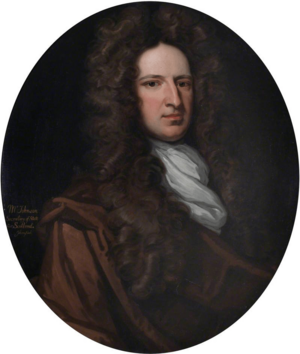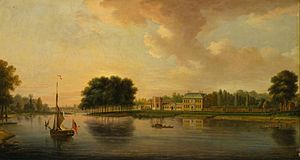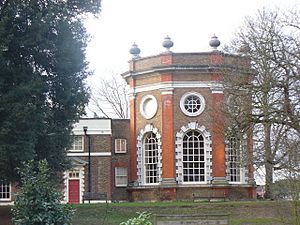James Johnston (Secretary of State) facts for kids
Quick facts for kids
James Johnston
|
|
|---|---|

James Johnston
|
|
| Joint Secretary of State, Scotland | |
| In office 1692–1696 Serving with John Dalrymple
|
|
| Succeeded by | John Murray, 1st Duke of Atholl |
| Envoy extraordinary to Prussia | |
| In office 1690–1692 |
|
| Lord Clerk Register | |
| In office 1704–1705 |
|
| Member of the House of Commons | |
| In office 1708–1710 |
|
| Constituency | Ilchester |
| Member of the House of Commons | |
| In office 1710–1713 |
|
| Constituency | Calne |
| Personal details | |
| Born | baptised: 9 September 1655 |
| Died | 3 May 1737 (aged 82) Bath, Somerset |
| Spouses | Catharine Poulett Lucy Claxton |
James Johnston (born around 1655 – died 3 May 1737) was an important Scottish diplomat and politician. He worked as an envoy (a special messenger) to Prussia from 1690 to 1692. He also served as a Secretary of State for Scotland and later as the Lord Clerk Register, a high-ranking government official. From 1708 to 1713, Johnston was a member of the House of Commons of Great Britain, which is part of the British Parliament.
Contents
Early Life and Escape
James Johnston was born in 1655, near Edinburgh, Scotland. His father, Archibald Johnston, was a well-known figure who had supported Oliver Cromwell during a time of big changes in England. Because of this, King Charles II ordered his father's execution in 1663.
After his father's death, James and his family had to flee Scotland. They found safety in the Dutch Republic (modern-day Netherlands). James studied law in the city of Utrecht.
A Role in the Glorious Revolution
After traveling around Europe, James Johnston became a secretary to Henry Sidney in 1687. He played a big part in helping Sidney with the Glorious Revolution. This was a major event in 1688 when William of Orange became King of England. Johnston returned to England with William of Orange's expedition.
As a reward for his help, James Johnston was appointed as an envoy to Prussia. He served in this role from 1690 to 1692. During his time there, he presented the Elector of Brandenburg with a special gift: the Order of the Garter, a very important award.
Serving Scotland
When James Johnston returned from Germany in 1692, he was given a very important job. He became a Joint Secretary of State for Scotland, sharing the role with John Dalrymple. He also became a member of the Scottish Privy Council, a group of advisors to the monarch.
Challenges in Office
Johnston was a dedicated Presbyterian, a type of Protestant Christian. His co-secretary, Dalrymple, was an Episcopalian, another Christian group. These differences led to a lot of disagreements and rivalry between them. Their constant arguments made it hard for the Scottish government to work properly. Because of this, both men were eventually removed from their positions in 1696.
After leaving his role, Johnston moved to England. He married Catharine Poulett in June 1696. For the next eight years, he stayed close to the royal court, looking for new opportunities.
Return to Politics
In 1704, James Johnston returned to a leading role in Scottish politics. He was again appointed to the Scottish Privy Council. He also became the Lord Clerk Register, a very important and well-paid government job.
However, after spending eight years in England, some people in Scotland saw him as an outsider. He faced some public dislike, with people even throwing stones at his windows. Because of this, he decided to take refuge back in England. He was dismissed from his Lord Clerk Register post in 1705.
In the British Parliament
In 1708, James Johnston was elected as a Member of Parliament for Ilchester. He was supported by the Tory party, which was his wife's family's political group. He didn't play a very active role in Parliament during this time.
In 1710, he was elected as an MP for Calne. Again, he didn't participate much in parliamentary debates. He was, however, known as a "worthy patriot" for helping to uncover problems with the previous government. He also joined a political group called the October Club. Towards the end of this period, he started to have health issues and did not run for re-election in 1713.
Life in Retirement
After his political career, James Johnston settled in Twickenham, a town on the Thames river near London. In 1702, he started building a grand home there, which later became known as Orleans House. He hired an architect named John James for the project, which took 35 years to complete.
Johnston created a beautiful and large garden around his house. It featured canals, an icehouse, and different types of gardens, including a fruit garden and a grotto. In 1720, a special octagonal (eight-sided) room was added to the house. This room was designed by the famous architect James Gibbs and was used to entertain important guests, like Queen Caroline.
Johnston was well-liked by royalty. It was said that King George I often visited him and that Queen Caroline enjoyed his sense of humor. He was known for hosting important people at his country house.
Family and Passing
James Johnston passed away in Bath in May 1737, at the age of 82. He was buried in Twickenham. He had a son and a daughter who survived him from his third marriage to Lucy Claxton in 1716.
His eldest daughter, Lucy, married General George Preston. His son, also named James Johnston, became a General in the army. He commanded famous regiments like the Royal Horse Guards and the Scots Greys.
|




